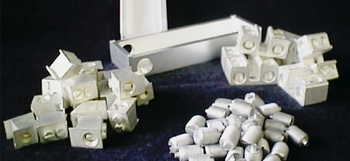Silver Plating
Silver plating services for manufacturers and restorers. Electronics and Radio Frequency parts – plus trophies, serving-ware, religious, more.

Description of Silver Plating
Silver plating is an electrolytic process. Its properties can be utilised for either “functional” purposes such as enhanced electronic performance, corrosion resistance, or “decorative” purposes. Silver is commonly applied over preliminary coatings of copper and nickel though depending on the application this may vary.
Household silverware is sometimes described as “EPNS” which stands for “Electro-Plated Nickel, Silver”. An EPNS item in good condition will be difficult to tell apart from a sterling silver (solid silver) item as the surface is actual silver. Silver plating enables us to achieve or experience the look, feel and performance of silver metal – without bearing the cost of “solid” silver.
Colour & Aesthetics of silver
Silver plating has a ‘white’ hue and to achieve a bright finish is applied over a layer of bright nickel plating. Otherwise, silver has a dull, velvety appearance. To help maintain a bright silver appearance, it requires polishing. To avoid frequent polishing, silver can be lacquered or clear coated over the polished silver surface, though such coatings may deteriorate over time.
Benefits of silver plating
Functional (helps to achieve a function other than “looking good”). Silver plating enhances electrical/electronic and radio wave conductivity. In a “high purity” form it is possible to achieve surface silver of around 99.99% purity (providing maximum conductivity). This can be of significant benefit to manufacturers seeking to maximise the quality of signal receiving or transmission.
Decorative − Silver coatings enrich the look and feel of a product − adding to the impression of quality and ‘class’. Next time you have the chance to compare, eat from silver cutlery and compare the experience to that of stainless steel. You’ should notice the silver has a ‘warmer’ or ‘softer’ feel.
Applications for silver plating
“Functional” silver plating examples we have plated here at A Class include: high-tech Electrical, Electronic or Radio Frequency components such as antennas, bus bars and connectors. “Decorative” applications commonly include silverware (teapots, trays, trinkets, etc), jewellery, trophies or hand crafted art pieces.
Substrates suited to silver plating
Silver can be plated over most metal substrates but is commonly used on brass or copper substrates. High tech applications can often involve substrates such as aluminium or alloys.
Design Cautions – before silver plating
As this is an electrolytic process it is necessary to use jigging, racking or wiring to provide for optimum electrical conductivity, and even-as-possible coverage of the part. Some shapes lend themselves more easily to this than others. In some cases the addition of a sprue or hole is necessary, or we may suggest, for example rounding of sharp corners to avoid high build up on corners. Please consult our plating department prior to finalising design if you intend to use this finishing process.


ONLINE QUOTE
We are no longer providing estimates for Metal Restoration work. If you are a manufacturer requiring finishing for your ready to plate commercial products or components click on "Quote for new parts finishing" and you will be directed to the business we sold our commercial plating operations to. Note - they DO NOT offer metal restoration or refurbishment services.
